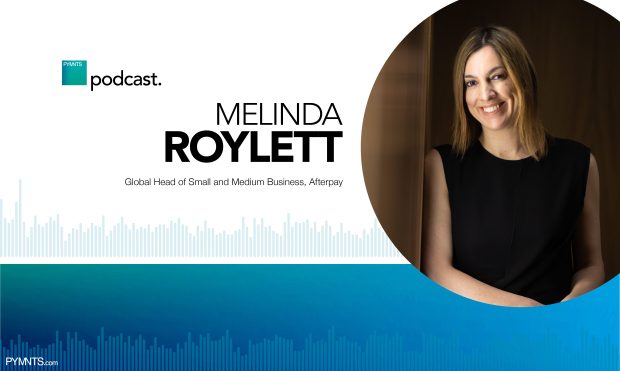For SMBs, Buy Now, Pay Later Is Much More Than Just A Payment Method

As the world begins to reopen and consumer spending habits shift back offline, the buy now, pay later (BNPL) train has kept chugging along as more and more businesses hop on board.
Though much of the buzz around BNPL relates to the consumer benefits derived by providing a flexible way to pay, there’s a huge business use case that’s driving growth, too, as the installment purchase plans that spread payments are bringing traffic to both digital and physical stores.
At least that’s the case with Afterpay, which was recently acquired by Square for $30 billion and has a broad appeal with younger generations.
“One of the reasons small businesses choose to work with us is that we’re not just a payment method,” Afterpay Global Head of SMB Melinda Roylett told PYMNTS in an interview. “We’re also a way for them to attract traffic, particularly with Generation Zers and millennials who are accounting for more and more of global online spending.”
You may also like: What The Square Afterpay Deal Means For BNPL, FinTech, BigTech And Banks
BNPL Vs. Bailout
Roylett said this unique benefit enabled BNPL to play a critical role in the resilience strategy of thousands of small businesses during the COVID-19 pandemic, where many had been pushed to the brink and were relying on stimulus funds or government loans to stay afloat.
“Some of the stories we’ve heard about small businesses being able to adapt to new trends faster than established ones have been really heartwarming to hear,” she said. “BNPL is a part of those trends, because it allows people to pay in installments online and in stores and allows payment flexibility, so small businesses are taking advantage of that.”
What makes BNPL so attractive, she said, is that it gives people more versatility over their payments without actually having to pay for it. Afterpay doesn’t make money through charging its customers interest or by upselling plans with APRs.
Merchants Are Happy To Pay
“One of the things we’re most proud of is that we don’t make our fees from our consumers,” she said. “We charge merchants [a fee], and they are happy to pay because it adds value.”
See more: Report: Young Consumers Want BNPL, 95 Pct Of SMBs Don’t Offer It
That value comes in the form of the huge amount of new business BNPL drives to merchants, which might otherwise have passed by had a business not offered the fast-growing payment method. Roylett claimed that in the case of Afterpay, omnichannel customers who shop both online and offline spend 176 percent more in terms of purchase volume than online-only shoppers.
“We’re sending an average of one million leads to our retail partners every day through the Afterpay shop directory,” she said. “Small businesses rely on these leads. To navigate through these tougher economic times, they rely on us as a retail partner and a marketing partner, and not just a payments partner. It’s really important for them.”
Growing The BNPL Pie
As a result, BNPL will only grow in importance for small and medium-sized business (SMB) strategies, Roylett believes, pointing to the findings in Afterpay’s latest Next-Gen Index report, which shows how payments volume grew by 230 percent over the past year. That was far faster than traditional debit cards, which grew by just 43 percent, and credit cards, which were stuck in the single digits.
Read more: BNPL Bulks Up Sales Of Protein Shakes And Sports Nutrition Products
According to Afterpay’s latest Next-Gen Index report, the majority of that growth is being driven by Generation Z and millennials — and Roylett said this is very good news for small businesses. “Those generations are much more apt on shopping at smaller retailers,” she said. “They really like to buy unique things that no one else can get.”
The same report forecasts how Generation Z and millennials are expected to account for 50 percent of all global spend by 2030. “Given the growth rates we’re seeing in buy now, pay later, it means it’s going to see more and more penetration as a payment method with respect to the total payments pie,” Roylett said. “As those demographics represent more and more of society, it’s definitely going to be a rosy picture for smaller businesses.”
Further reading: BNPL Firm Afterpay Launches Data Platform For Merchants
Good Debt Vs. Bad Debt Vs. Responsible Debt
One scenario that could possibly hinder BNPL’s growing dominance of the payments space is if too many of those younger consumers end up getting themselves in trouble. One of the favorite criticisms leveled at BNPL is that shoppers might not be aware of the risks of taking on too many installments and what happens if they miss a payment. There’s a danger that they could run up debts they’re unable to repay, critics say.
But Roylett brushed off those concerns, pointing out that BNPL’s repayment rates compare very well with traditional financing schemes. She said that being a responsible lender is a core part of Afterpay’s business model. “Some 90 percent of all our transactions take place with debit cards, which is very much people using their own money,” she said. “Ninety-five percent of our customers don’t ever pay late fees, and a third of our customers actually pay us back early.”
“We’re very much up for responsible lending, and we reward people who pay us back on time,” Roylett added.